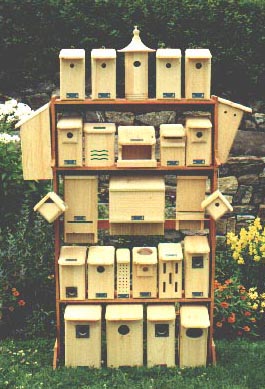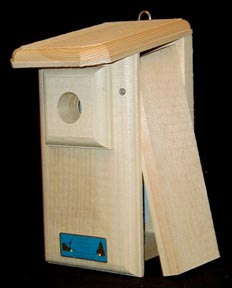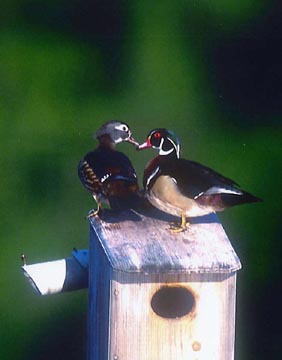
   |
 |
|
|
|
||||||||||||||||||||||||||||||||||||||||||||||||||||||||||||||||||||||||||||||||||||||||||||||||||||||||||||||||||||||||||||||||||||||||||||||||||||||||||||||||||||||||||||||||||||||||||||||||||||||||
 Coveside "BAT" Chelor Pad
Coveside "BAT" Chelor Pad
Houses up to 30 bats in a single chamber. Features include a large screened landing pad, roughened interior surface and an echolocation slot. Designed for cooler locations preferred by solitary males, but also suitable for a small nursing colony. (20"h x 10"w x 3"d) |
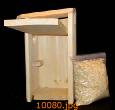 Coveside American Kestrel House
Coveside American Kestrel House
Formerly called the Sparrow Hawk, the kestrel eats insects and small rodents. House includes an internal perch (shown in photo with door open) so mother and babies can keep an eye out for their next meal. RANGE: Breeds from Alaska and Northwest Territories east through Maritime Provinces, and south throughout continent. Winters north to British Columbia, Great Lakes and New England. HABITAT: Lives in towns and cities, parks, farmlands, along highways and in open country. (17-3/4"h x 9-1/2"w x 11"d) |
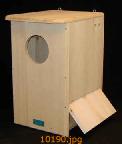 Coveside Barred Owl House
Coveside Barred Owl House
The Barred Owl is slightly larger than a barn owl and sounds like a typical "hoot owl." This house can be mounted high in a tree with the two metal hangers. Bottom of side opens for ease in cleaning. RANGE: Resides from British Columbia east to Nova Scotia, and south to northern California, and to Texas and Florida. HABITAT: Lives in low, wet woods and swampy forests. (25"h x 14-1/4"w x 19"d) |
 Coveside Bat Beacon
Coveside Bat Beacon
This easy-to-mount bat house is designed to fit on a standard purple martin pole. With three chambers and an attic, it provides an ideal free-standing habitat for establishing a bat colony. Have any bats taken up residency? The purple martin pole makes lowering easy and the side opens for convenient inspection.(25"h x 8"w x 7-1/2"d) |
 Coveside Bat Condominium
Coveside Bat Condominium
This best seller accomodates over 50 bats and is ideal for a nursing colony. The vertical house contains 4 chambers and can be easily mounted by a hanger on a building or a tree. (19"h x 9-1/2"w x 7-1/2"d) |
 Coveside Bat House Kit
Coveside Bat House Kit
This top seller features a single chamber which will hold up to 20 bats. Similar in design to the "BAT"chelor Pad, but smaller. Features an extended landing pad and an interior covered with screening to provide bats with a maximum foothold. Also includes echolocation slot to help the bats locate the cavity. Designed to be an educational tool for youngsters, and adults alike. It comes with easy-to-follow instructions and information about bats. (16"h x 8"w x 3-3/4"d) |
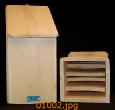 Coveside Bat Mansion
Coveside Bat Mansion
Houses several hundred bats in five chambers plus an attic, which provides for greater temperature stability. Bats seek most comfortable temperture by moving up or down inside the house. A popular house because of its large capacity. (25"h x 11"w x 11"d) |
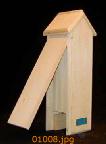 Coveside Bat Tower
Coveside Bat Tower
Latest research indicates that the most successful bat houses are mounted on buildings or are free-standing. The innovative bat tower mounts directly on a 4x4 post. The post actually becomes the landing platform, and from there bats climb into the house. The four internal chambers and attic provide for multiple roosting opportunities. In addition, the side opens to quell the curiosity of the serious "bat-o-phile." (Picture shows house with door partially opened.). (23"h x 6-3/4"w x 7"d) |
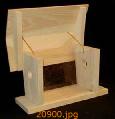 Coveside Bluebird Feeder
Coveside Bluebird Feeder
This feeder is designed to protect not only bluebirds, but all smaller birds. Entrance holes on the end allow little ones in, but keep starlings and other large birds out. Extended landing platform provides outside perches at each end. Bluebirds feed inside on berries and fruit, or mealworms and insects. Top swings up for easy filling. Mount on a post, pole or hang from attached cord. (10-1/2"h x 15"w x 10-3/4"d) |
 Coveside Bufflehead Duck House
Coveside Bufflehead Duck House
The Bufflehead, with its striking white sides and white patch on its head, is smaller than most cavity nesting ducks.Dependent on nest boxes, this house is ideal due to the scarcity of holes excavated by a large woodpecker or flicker. RANGE: Breeds in Alaska east to western Quebec, and south in mountains to Washington and Montana. Winters in southern U.S., south to Mexico, Gulf Coast and northern Florida. HABITAT: Nests on wooded lakes and ponds; winters mainly on salt bays and estuaries. (17-3/4"h x 9-1/4"w x 11"d) |
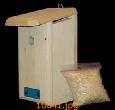 Coveside Chickadee House
Coveside Chickadee House
Properly sized to shelter one of America's favorite backyard birds. Opens easily for monitoring and cleaning. RANGE: Resides throughout eastern United States. HABITAT: Prefers open forests of mixed growth, orchards and swamps. (12-1/2"h x 6"w x 8-1/2"d) |
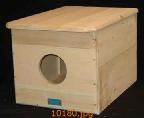 Coveside Common Barn Owl House
Coveside Common Barn Owl House
The Barn Owl with its heart-shaped face is 18" high with a wing span of 44". These highly valued, rodent-eaters will have an ideal residence in this very large house which comes with wood chips. RANGE: Resides from southern British Columbia east through the Dakotas and Michigan to southern New England, and southward. HABITAT: Lives in open country, forest edges and clearings, cultivated areas, cities and farms. (17"h x 20"w x 26"d) |
 Coveside Common Merganser Duck House
Coveside Common Merganser Duck House
This house provides a perfect nest box for mergansers that normally nest in tree cavities. Positioning a house on a pole in the open water provides extra protection from predators. RANGE: Breeds across Canada from eastern Alaska, Manitoba and Newfoundland south in mountains to California, northern New Mexico, Great Lakes and northern New England. Winters south to northern Mexico and Georgia; also in Eurasia. HABITAT: Breeds on wooded rivers and ponds; winters mainly on lakes and rivers, occasionally on salt water. (24-1/4"h x 11"w x 13"d) |
 Coveside Conservation Mirrored Windowsill Feeder Natural
Coveside Conservation Mirrored Windowsill Feeder Natural
Coveside Conservation windowsill feeders will give you plenty of up close bird viewing from the comfort of your home. The feeders are designed to sit on your windowsill and are held in place by easy to use spring set dowels that fit securely in the screen window tracks. •Open Back and acrylic top gives you plenty of great viewing • Fits double hung windows up to 38" wide • Perforated metal screen feeding platform for proper drainage. • Clean and fill from the inside of your house |
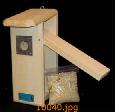 Coveside Downy Woodpecker House
Coveside Downy Woodpecker House
America's smallest woodpecker, the Downy is a
backyard favorite. They are friendly little birds that
enjoy being around people. Since Downys tend to use nest boxes in the winter as
roosts to escape the cold, one might want to put up a house in the fall. Comes
standard with slate squirrel guard and wood chips. |
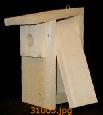 Coveside Eastern Bluebird House Kit
Coveside Eastern Bluebird House Kit
This bird house has a 4"x4" floor, which is suitable for a variety of small birds: chickadees, titmice, wrens, warblers, nuthatches and tree swallows. Includes a predator guard that is essential to provide protection for bluebirds. Easy to assemble with instructions and bird information included. (14"h x 6"w x 7-1/2"d) |
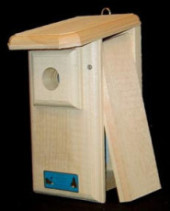 Coveside Eastern Bluebird House
Coveside Eastern Bluebird House
The finest bluebird house on the market! Predator guard is standard to keep starlings, squirrels and other undesirables out, while small floor discourages sparrow nests. RANGE: Breeds east of the Rockies from southeastern Canada to Gulf of Mexico. Winters in southern part of breeding range and Mexico. HABITAT: Enjoys open woodlands, fields and farmlands with scattered trees. (12-1/2"h x 6"w x 8-1/2"d) |
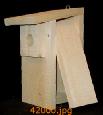 Coveside Economy Bluebird House
Coveside Economy Bluebird House
Same functionality as our standard Eastern Bluebird House, but a "no frills" variety without the pretty features that don't impress the birds. For those who want to put up an extensive bluebird trail at a reasonable price. (12-1/2"h x 6"w x 8"d) |
 Coveside Flycatcher House
Coveside Flycatcher House
This house suits the Great Crested Flycatcher of the eastern U.S., (or the Ash-throated Flycatcher of the Southwest). RANGE: Breeds in the East from the southern part of the eastern half of Canada, south to the Gulf Coast. Winters in southern Florida and the tropics. HABITAT: Enjoys open forests, orchards and large trees in farm country. (12-1/2"h x 6-3/4"w x 9"d) |
 Coveside Goldeneye Duck House
Coveside Goldeneye Duck House
Unable to excavate their own cavities, goldeneyes are in constant search for good nesting sites. With a larger entrance hole than the Wood Duck House, this box comes with wood chips and a ladder to provide an ideal place for goldeneyes to lay their eggs. RANGE: Breeds in Alaska and across Canada to Newfoundland and the Maritime Provinces, south to mountains in Montana and Great Lakes. Winters in much of U.S., wherever water is open; also in Eurasia. HABITAT: Breeds on wooded lakes and ponds; winters mainly on coastal bays and estuaries. (24-1/4"h x 11"w x 13"d) |
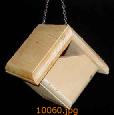 Coveside Hanging Carolina Wren House
Coveside Hanging Carolina Wren House
The Carolina Wren, like the House Wren, doesn't mind a house that sways. The entrance is larger than that of the House Wren. The extra width gives Carolina Wrens the ability to carry wide sticks into their house for nesting material. Hangs with a metal chain and opens easily for clean-out. (7-1/2"h x 7-3/4"w x 7-1/2"d) |
 Coveside Hanging Screen Feeder Legs
Coveside Hanging Screen Feeder Legs
These four legs fit on the corners of an of our screen feeders or the Cottage Feeder to convert it to a ground feeder that sits six or eight inches above the ground. With proper positioning, the legs can easily adapt a screen feeder, Cottage Feeder or hopper feeder to rest securely on a deck rail. Eack leg is pre-drilled and secured with the two screws provided. (10"h x 2-1/2"w x 3/4"d) |
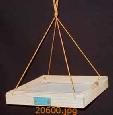 Coveside Hanging Screen Feeder
Coveside Hanging Screen Feeder
With durable, perforated metal bottom providing drainage to keep seed from spoiling, this one-foot-square platform hangs nicely from a shephard's hook or a hanging bracket by a sturdy nylon cord. Screen removes easily for cleaning. (2"h x 13"w x 13"d) |
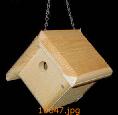 Coveside Hanging Wren House
Coveside Hanging Wren House
Most birds prefer a stable house, but House Wrens don't mind a gentle movement. Hangs easily with the metal chain from a tree or bracket and opens easily for clean-out. RANGE: Breeds west across Canada to Washington and south to northern Georgia, Tennessee, northern Texas and southeastern Arizona. HABITAT: Thrives in residential areas, city parks, farmlands and woodland edges. (7-1/2"h x 7-3/4"w x 7-1/2"d) |
 Coveside Horizontal Bluebird Box
Coveside Horizontal Bluebird Box
Designed by Frank Zuern to be a safer nesting place for Eastern Bluebirds, this horizontal box simulates a hollow tree branch. Over 90% nest near the back of the box, behind a vertical baffle, out of the reach of predators. RANGE: Breeds east of the Rockies from southeastern Canada to Gulf of Mexico. Winters in southern part of breeding range and Mexico. HABITAT: Prefers open woodlands and farmlands with scattered trees. (6-1/4"h x 6"w x 19-3/4"d) |
 Coveside House Wren House
Coveside House Wren House
With its 1" entrance hole, this house provides great protection for house wrens. Wrens are very protective, so position the nest box in less frequented areas or you might get a scolding from a disgruntled parent. RANGE: Breeds west across Canada to Washington and south to northern Georgia, Tennessee, northern Texas and southeastern Arizona. HABITAT: Likes residential areas, city parks, farmlands, woodland edges. (12-1/2"h x 6"w x 8-1/2"d) |
 Coveside Large Sunshine's Bat House
Coveside Large Sunshine's Bat House
This special house was designed by Amanda Lollar, who rescued and rehabilitated a little bat named "Sunshine" and then wrote a book about her. Her field testing of many of these houses indicates that bats are readily attracted to and occupy this style. With two chambers and an open slot at the bottom, this abode is suitable for all species of small, insectivorous bats. Features include a screened landing platform, roughened interior surface and echolocation slots on the sides to help bats locate the hollow cavity. Can accomodate 100, 200 or 300 in three different sizes (small, medium and large). (18"h x 24"w x 6-1/2"d) |
 Coveside Mini Bat House
Coveside Mini Bat House
House a few bats in this small version of the "BAT"chelor Pad. Comes complete with echo-location slot and screening against the back. (16"h x 8"w x 3-3/4"d) |
 Coveside Mountain Bluebird House
Coveside Mountain Bluebird House
The largest of the bluebird houses, this box provides an ideal cavity for the only "all-blue" bluebird. RANGE: Breeds from southern Alaska, Mackenzie and Manitoba south to western Nebraska, New Mexico, Arizona and west to the coast. Winters from British Columbia and Montana south through western U.S. HABITAT: Breeds in high mountain meadows with scattered trees and bushes; in winter descends to lower elevations, where it prefers the plains and grasslands. (12-1/2"h x 7-1/4"w x 9"d) |
 Coveside Northern Flicker House
Coveside Northern Flicker House
The Northern Flicker is a woodpecker that utilizes a bird house quite readily. If there is a problem with a flicker pecking a hole in a building, fill the this house with wood chips and position it over the unwanted excavation to provide a more suitable nesting location. RANGE: Resides throughout the U.S. and Canada. HABITAT: Prefers open country with trees, parks and large gardens; especially in or at the edge of open woods.. (17-3/4"h x 9-1/4"w x 11"d) |
 Coveside Nuthatch House
Coveside Nuthatch House
Nuthatches are secondary cavity dwellers so they look for a nesting location that has already been established naturally or by another bird. Locate housing away from buildings in a mature forest as best protection from house sparrows. RANGE: Resides throughout eastern U.S. except southern Florida. HABITAT: Likes mixed woodlands, village trees and orchards. (12-1/2"h x 6"w x 8-1/2"d) |
 Coveside Open Top Bluebird House
Coveside Open Top Bluebird House
This sparrow-resistant house, similar to our standard bluebird house, has a circular opening in the roof. Naturally, bluebirds will nest in rotten fence posts and stumps, so sun and rain do not deter them. On the other hand, sparrows are not as tolerant. A durable, coated wire barrier prevents predators from entering through the top. In addition, a plastic cap is included to provide shelter after the bluebirds have started nesting and/or can be used to feed mealworms to hungry chicks. RANGE: Breeds east of the Rockies from southeastern Canada to Gulf of Mexico. Winters in southern part of breeding range and Mexico. HABITAT: Enjoys open woodlands, fields and farmlands with scattered trees. (12-1/2"h x 6"w x 8-1/2"d) |
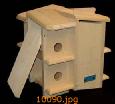 Coveside Purple Martin House
Coveside Purple Martin House
In the East, Purple Martins are attracted to houses
with multiple apartments to establish colonies.
This house opens on four sides for
easy cleaning and mounts securely on a pole. |
 Coveside Screech Saw-Whet Owl House
Coveside Screech Saw-Whet Owl House
Saw-whet owls and screech owls have tough competition from other birds because they are so small. This house provides a perfect cavity, complete with wood chips for nesting material. RANGE: Breeds from southeastern Alaska east across central Canada to Nova Scotia and south to southern California, Arizona, Illinois, North Carolina (in mountains) and Connecticut. Winters in breeding range and south to Arkansas and North Carolina. HABITAT: Nests in deep woods, preferably near swamps. Likes coniferous woods and evergreen thickets in parks and gardens. (17-3/4"h x 9-1/4"w x 11"d) |
 Coveside Slant Front Bluebird House
Coveside Slant Front Bluebird House
This design is popular because it discourages cats and other predators. Since the bottom tapers, less nesting material is needed. The front opens easily for observation and cleaning. Mount this box high on a post so that potential occupants can be easily observed from a distance. RANGE: Breeds east of the Rockies from southeastern Canada to Gulf of Mexico. Winters in southern part of breeding range and Mexico. HABITAT: Enjoys open woodlands, fields and farmlands with scattered trees. (17"h x 7"w x 9"d) |
 Coveside Slate Squirrel Guard
Coveside Slate Squirrel Guard
This guard is used with the following nesting houses: Window Nest Box, Chickadee, Nuthatch, Titmouse, House Wren, all Bluebird Houses, Saw-Whet Owl and Kestrel. This guard will protect the box from chewing squirrels. |
 Coveside Small Sunshine's Bat House
Coveside Small Sunshine's Bat House
This special house was designed by Amanda Lollar, who rescued and rehabilitated a little bat named "Sunshine" and then wrote a book about her. Her field testing of many of these houses indicates that bats are readily attracted to and occupy this style. With two chambers and an open slot at the bottom, this abode is suitable for all species of small, insectivorous bats. Features include a large, screened landing platform, roughened interior surface and echolocation slots on the sides to help bats locate the hollow cavity. Can accomodate 100, 200 or 300 in three different sizes (small, medium and large). (18"h x 14"w x 6-1/2"d) |
 Coveside Small Winter Roosting House
Coveside Small Winter Roosting House
This economical winter roost provides protection from the cold for most common backyard birds including wrens, chickadees, nuthatches, titmice and bluebirds. The 1-1/2" hole located at the bottom of the front panel is protected by a slate guard. The three internal perches can accommodate 6 or more birds. Shown on left with front door open. (13"h x 7"w x 9"d) |
 Coveside Small Wood Duck House
Coveside Small Wood Duck House
"Dump nesting" occurs when a number of females lay eggs in a single house, which sometimes results in clutches with over 70 eggs. Mississippi State University did a study of Wood Ducks in an effort to reduce this problem. A smaller nest box was designed and "dump nesting" was reduced. Although fewer ducklings are fledged from each box, the survival rate is improved and the cost per fledgling is less. This box comes with a wire ladder and nesting chips, and the front opens for observation and cleaning. RANGE: Breeds from British Columbia south to California, and from Montana east to Nova Scotia, and south to Texas and Florida; absent from Rocky Mountains and Great Plains. Winters near Pacific Coast north to Washington, and to New Jersey in East, rarely further north. HABITAT: Nests beside wooded rivers and ponds. Visits freshwater marshes in late summer and fall. (17"h x 7-1/2"w x 15"d) |
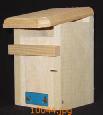 Coveside Sparrow Resistant Bluebird House
Coveside Sparrow Resistant Bluebird House
This Kentucky style, slot entrance bluebird house is designed to thwart sparrows. According to research at the University of Kentucky, bluebirds prefer a slot entrance to the standard circular hole -- sparrows prefer the opposite. In addition, sparrows don't like a shallow box and bluebirds don't seem to mind. This box is only 5" deep but if sparrows still continue to be a problem, a wooden insert is included to reduce the depth even more. Sparrows rarely use the 3-1/2" depth, but bluebirds will still occupy it. RANGE: Breeds east of the Rockies from southeastern Canada to Gulf of Mexico. Winters in southern part of breeding range and Mexico. HABITAT: Enjoys open woodlands, fields and farmlands with scattered trees. (10"h x 6"w x 8-1/2"d) |

Home
Page |
Product Review Page | Help
 Woodside Gardens
The Registry of Nature Habitats
Woodside Gardens
The Registry of Nature Habitats 
 1999 -
1999 -
All Rights Reserved
Last Updated:
